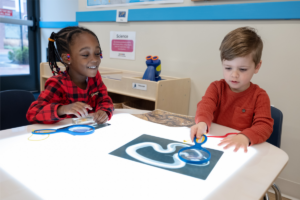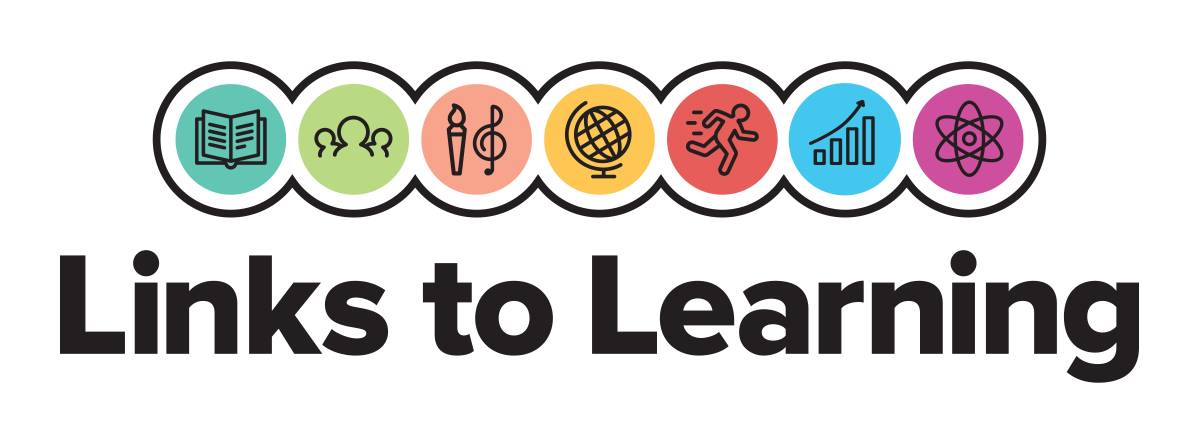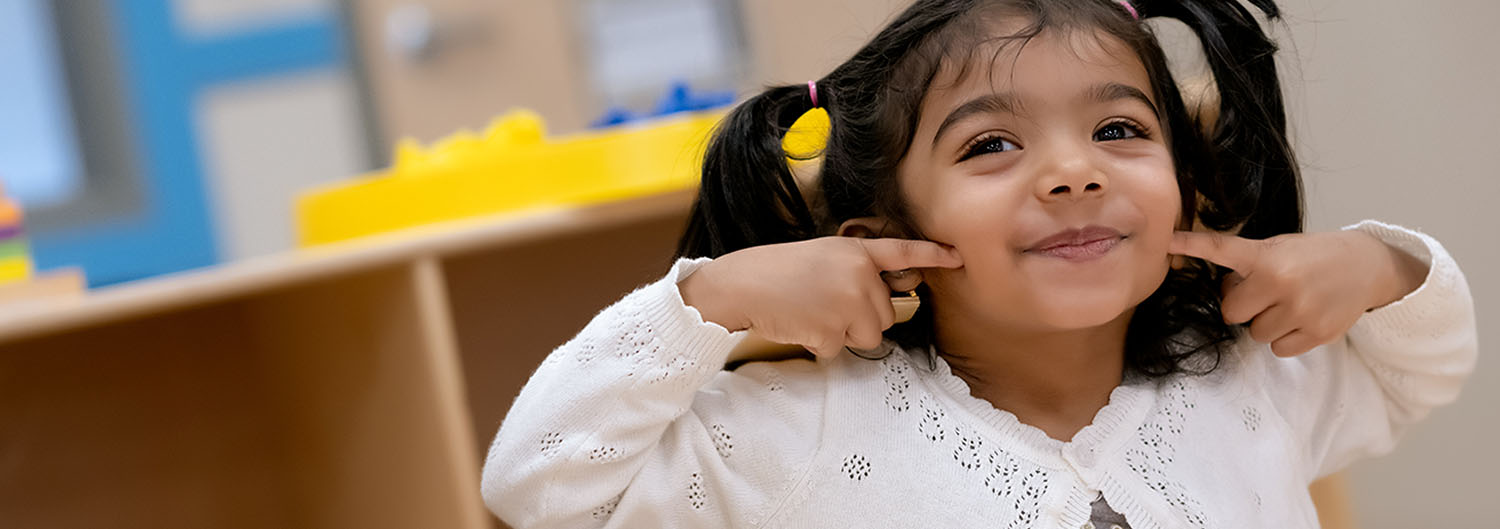 Have you heard the phrase ‘classroom centers,’ but have no idea what that refers to or how it helps your child’s development? If so, you’ve come to the right place.
Have you heard the phrase ‘classroom centers,’ but have no idea what that refers to or how it helps your child’s development? If so, you’ve come to the right place.
We’re diving headfirst into all things centers with our Director of Educational Services, Erin Pastushok. With nearly three decades of experience in early childhood education, Erin has worn various hats, including that of a teacher, principal, and now director. She is a certified Infant, Toddler, and Family Specialist through the North Carolina Infant Toddler Program, as well as a certified Trainer through the Center on the Social and Emotional Foundations for Early Learning (CSEFEL).
Hi Erin! What are centers and what types are found in our classrooms?
Erin: Centers are defined areas of the classroom that allow for hands-on learning in smaller groups. Teachers purposefully group items and materials together in centers that encourage particular types of play based on the interests and skills of their students. Depending on the age of the children, our classroom centers include Construction, Dramatic Play, Manipulatives, Sensory, Art, Writing, Science, Language and Literacy, and Music. Hands-on learning is one of the best ways to teach children, which is why centers are a hallmark of our Links to Learning curriculum.
How do centers contribute to a child’s learning and development?
Erin: A child’s impulse to ask questions, to investigate, and to explore comes from a burning curiosity about the world. Learning through hands-on play within centers allows children to make connections between abstract concepts and real-world experiences. It helps them build foundational skills, such as problem-solving, cooperation, communication, and self-regulation, all while having fun and staying motivated. Because of this, our students spend more than a third of their school day in centers!
Can you share examples of how you’ve seen children make significant developmental strides in centers?
Erin: Centers are designed to provide holistic learning experiences that promote growth in all forms of development. I’ve seen students make large strides in their social-emotional development while exploring in centers. They develop cooperative play skills, such as taking turns and resolving conflicts using words. Center-based learning also fosters positive interactions between students and teachers. These social-emotional skills are all imperative for having positive interactions and relationships in the future. Through discussions in centers about feelings, students develop empathy and learn to manage their emotions. In terms of academic skills, I’ve seen students improve their addition skills by simply using materials that interest them; for example, building a tower in the Construction center and grouping and counting the blocks used. The possibilities are truly endless.
It sounds like centers are very collaborative. How do teachers encourage problem-solving and teamwork with students who may be shy or timid?
Erin: That’s the beauty of centers. They give teachers the opportunity to personalize the learning for every child. Teachers provide open-ended materials, model problem solving, and encourage students to work together to achieve a common goal (i.e., building a structure with blocks, creating group artwork). Teachers also integrate real-life scenarios, such as setting up a restaurant where children take on different roles, collaborate to prepare meals, and solve problems related to customer service.
How do teachers create a safe and supportive environment within centers?
Erin: Teachers prioritize safety in centers because we know that when children feel safe, they are more likely to take risks in their learning and collaborate more freely. Each of our classrooms have an established Center Management System at student eye level. This empowers students to navigate each center independently, choose materials, and engage with activities. A Center Management System might be a sign with Velcro pieces indicating the maximum number of students allowed at that center and photographs of each student with their name clearly labeled. When a child wants to use a center, they place their photo onto the center sign of their choice. When they want to leave the center, they put away the materials, remove their photo, and choose a new center.
How do centers remain interesting to children over time?
Erin: Teachers rotate materials regularly to maintain their students’ interest. Think about how your child gets bored of their toys at home. If you put those toys away for a bit and bring them back out in a month or so, it’s like they are brand new all over again. We do the same in our classrooms. As I previously mentioned, we also include open-ended materials, such as blocks and objects from nature. These can be used in a variety of ways, encouraging students to use their imagination to create and explore.
To wrap up our conversation, what can families do to reinforce and complement the learning their child gains from participating in centers at school?
Erin: Create a learning environment in your home by designating a safe, specific area stocked with age-appropriate books, educational toys, art supplies, and other materials that encourage exploration and creativity. Equip this space with hands-on activities like puzzles, building blocks, and simple science experiments, all designed to nurture problem-solving and fine motor skills. Within this environment, continue to have conversations with your child. Ask open-ended questions and encourage them to freely articulate their thoughts and feelings. This not only nurtures their language proficiency but also cultivates critical thinking.




Exploring Centers: What They Are and Why Your Child Will Love Them
We’re diving headfirst into all things centers with our Director of Educational Services, Erin Pastushok. With nearly three decades of experience in early childhood education, Erin has worn various hats, including that of a teacher, principal, and now director. She is a certified Infant, Toddler, and Family Specialist through the North Carolina Infant Toddler Program, as well as a certified Trainer through the Center on the Social and Emotional Foundations for Early Learning (CSEFEL).
Hi Erin! What are centers and what types are found in our classrooms?
Erin: Centers are defined areas of the classroom that allow for hands-on learning in smaller groups. Teachers purposefully group items and materials together in centers that encourage particular types of play based on the interests and skills of their students. Depending on the age of the children, our classroom centers include Construction, Dramatic Play, Manipulatives, Sensory, Art, Writing, Science, Language and Literacy, and Music. Hands-on learning is one of the best ways to teach children, which is why centers are a hallmark of our Links to Learning curriculum.
How do centers contribute to a child’s learning and development?
Erin: A child’s impulse to ask questions, to investigate, and to explore comes from a burning curiosity about the world. Learning through hands-on play within centers allows children to make connections between abstract concepts and real-world experiences. It helps them build foundational skills, such as problem-solving, cooperation, communication, and self-regulation, all while having fun and staying motivated. Because of this, our students spend more than a third of their school day in centers!
Can you share examples of how you’ve seen children make significant developmental strides in centers?
Erin: Centers are designed to provide holistic learning experiences that promote growth in all forms of development. I’ve seen students make large strides in their social-emotional development while exploring in centers. They develop cooperative play skills, such as taking turns and resolving conflicts using words. Center-based learning also fosters positive interactions between students and teachers. These social-emotional skills are all imperative for having positive interactions and relationships in the future. Through discussions in centers about feelings, students develop empathy and learn to manage their emotions. In terms of academic skills, I’ve seen students improve their addition skills by simply using materials that interest them; for example, building a tower in the Construction center and grouping and counting the blocks used. The possibilities are truly endless.
It sounds like centers are very collaborative. How do teachers encourage problem-solving and teamwork with students who may be shy or timid?
Erin: That’s the beauty of centers. They give teachers the opportunity to personalize the learning for every child. Teachers provide open-ended materials, model problem solving, and encourage students to work together to achieve a common goal (i.e., building a structure with blocks, creating group artwork). Teachers also integrate real-life scenarios, such as setting up a restaurant where children take on different roles, collaborate to prepare meals, and solve problems related to customer service.
How do teachers create a safe and supportive environment within centers?
Erin: Teachers prioritize safety in centers because we know that when children feel safe, they are more likely to take risks in their learning and collaborate more freely. Each of our classrooms have an established Center Management System at student eye level. This empowers students to navigate each center independently, choose materials, and engage with activities. A Center Management System might be a sign with Velcro pieces indicating the maximum number of students allowed at that center and photographs of each student with their name clearly labeled. When a child wants to use a center, they place their photo onto the center sign of their choice. When they want to leave the center, they put away the materials, remove their photo, and choose a new center.
How do centers remain interesting to children over time?
Erin: Teachers rotate materials regularly to maintain their students’ interest. Think about how your child gets bored of their toys at home. If you put those toys away for a bit and bring them back out in a month or so, it’s like they are brand new all over again. We do the same in our classrooms. As I previously mentioned, we also include open-ended materials, such as blocks and objects from nature. These can be used in a variety of ways, encouraging students to use their imagination to create and explore.
To wrap up our conversation, what can families do to reinforce and complement the learning their child gains from participating in centers at school?
Erin: Create a learning environment in your home by designating a safe, specific area stocked with age-appropriate books, educational toys, art supplies, and other materials that encourage exploration and creativity. Equip this space with hands-on activities like puzzles, building blocks, and simple science experiments, all designed to nurture problem-solving and fine motor skills. Within this environment, continue to have conversations with your child. Ask open-ended questions and encourage them to freely articulate their thoughts and feelings. This not only nurtures their language proficiency but also cultivates critical thinking.